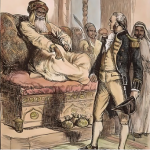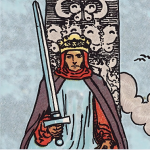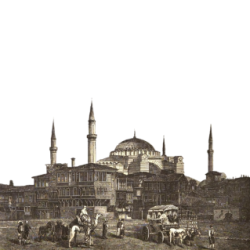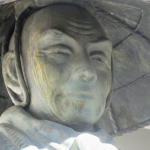A Tournament Of Shadows:
XIX. White Russia
Andrei Mikhailovich still resided in Telekhany with his father and still worked on the Oginsky Canal. The family was doing well; Pavel Mikhailovich (Andrei Mikhailovich’s brother) was now the right hand of Lieutenant Baron Karl Fedorovich Löwenstern, the chief of the artillery of the Second Army.[1] In this regard, Baron Löwenstern was on friendly terms with the Fadeev family. The army, as well as the Oginsky Canal, were both under the jurisdiction of General Ivan Ivanovich Falconiy. A native of the Dutch city of Breda, the fifty-seven-year-old Falconiy was well-acquainted with canals. (It was Falconiy who recommended artificial reservoirs to remedy the water shortages that occurred in mid-June.)[2] Until recently, he was in charge of the Land Engineering Corps “the scientific (i.e. technical) part,” of the Oginsky Canal, but on May 23, 1810, he was transferred to the Corps of Communications Engineers and appointed the District Commander of the Sixth District of Communications.[3]
The Neman was one of the most interesting rivers of European Russia. By this river, the most lucrative trade was carried out, especially in the transport of products from Lithuania, Podolia, and Minsk. With this new communication, the commerce of Belorussia (White Russia,) Malorossiya (Little Russia/Ukraine,) and Novorossiya (Southern Provinces/Southern Ukraine) would be facilitated. The Oginsky Canal was developing into the chief track of conveyance for those goods of Ukraine and the other Provinces near the Euxine to the Baltic. The trade after that would take its course to foreign ports (greatly to the disadvantage of the native merchants.) These canals would also make transporting “warlike stores” less difficult from the interior of Russia.[4]
The region where the Fadeevs lived, “Lithuanian Russia,” included part of the countries that great dukes conquered from the Russians in the thirteenth and fourteenth centuries. The palatinates of Polatsk, Vitebsk, Mstsislaw, and Minsk, made up Belorussiya (“White Russia,”) and the palatinate of Novogrudok was denominated Chornorossiya “Black Russia.” The origin of these names was uncertain, some authors claimed that the inhabitants of one province were clothed in white, while those of another confined themselves exclusively to dark attire. Another hypothesis was advanced that the words white and black were used to denote free and vassal. “Black Russia,” therefore, was first conquered by the Lithuanians, and the “White Russians” retained their name after they were later subdued. There was also “Red Russia” (Western Ukraine.) The forests and marshes in this region were extensive. Modern travelers avoided the roads here if possible. One contemporary account, given by a Frenchman traveling from Smolensk to Minsk, stated:
The road is often impassable, the villages are mean, and the peasants are poor. Most of the houses are inhabited by Jews, who are perhaps the most filthy people of any in Europe. Men, women, children, cattle, and poultry are all lodged under the same roof. We have often been constrained to share the only apartment in the dwelling with that numerous and select society. Spirits may be had everywhere, wine is not uncommon, and not very dear, but provisions can only be obtained in the towns which are thinly scattered, indeed most of them pass in other countries for wretched villages.
The cultivated land in Belorussia (White Russia,) produced barley, oats, wheat, turnips, and leguminous plants. Naval timber was plentiful in the forests, and the animals that frequented them included bears, elks, and wolves. The water (both stagnant and running) teemed with fish, and the bees (notwithstanding the severity of the climate) yielded an abundance of wax and honey. There were some peculiarities in the agricultural system in the region. The cycles of the earth had a certain correspondence with the Liturgical Calendar of the Orthodox Church. Wheat was typically sown in ashes. The peasants began cutting the brushwood around the festival of St. Peter and St. Paul (June 29,) and the branches were strewn on the ground (sometimes covered with straw.) The soil would remain for nearly a year in the same state, and the heap would be burned the following spring, usually on the first warm and dry day after Easter. Care was taken that the fire did not penetrate the earth, and the wheat was put into the ground after the surface was grazed with the light plow. Good soil was chosen for the purpose, and it was rendered extremely fertile by this sort of compost. If barley was the intended crop, all the branches were cut in a thick copse, but the trunks were not entirely destroyed. The wood obtained was burned afterward in the same manner. Late rye was the next crop (after wheat or barley.) The ground was labored twice, and, according to an old proverb, “the work must be commenced after the of the Assumption (August 15,) and before the birthday of the Virgin (September 8.)” If this rule was not strictly observed, the seed, it was supposed, “is sown in vain.” Summer secale was sown after Easter, barley and oats at Pentecost, peas before St. Peter’s Day, and turnips around the Festival of St. John. As for the peasants, it was stated:
The people are ignorant and poor. A stranger saw many White Russian peasants arrive at Riga […] Their clothing was sheep skins, and although conducted boats laden with corn, they suffered much from famine. The poor slaves slept on the ground or in hovels constructed with the remains of old planks, sold their cargo and their boats, they returned in same state that they came, and restored to their lords or their lords’ stewards the whole price of the goods, which always paid in ready money.
The towns in the government were not numerous. Mstsislaw, the metropolis of a Russian government, was the largest municipality. Located on the Dnieper, it contained 16,000 people and was favorable to trade. The town of Minsk, although the capital of a government, had only 3,000 inhabitants. In Telekhany, where the Fadeevs lived, there was a colony of Moldavians and Wallachians who migrated to the region for some cause that was now unknown. They spoke a Wallachian dialect mixed with Slavonic and Lithuanian words. Twelve miles away from Telekhany, situated in Grodno, was Slonim, one of the largest towns in the region with a population of five thousand individuals.[5]
SOURCES:
[1] Mikaberidze, Alexander Mikaberidze. The Russian Officer Corps Of The Revolutionary And Napoleonic Wars. Savas Beatie. New York, New York. (2005): 232.
[2] Band, Erster. Hydrographie Des Russischen Reiches. J. Ch. Stuckenberg. St, Petersburg, Russia. (1844): 172.
[3] Ivan Ivanovich Falconiy began his career as an engineer-lieutenant in the Dutch Service, but by the Imperial Decree of 1783, he was accepted into the Russian service as an Engineer Captain in the Field Engineering Corps. In 1784 he was sent from St. Petersburg to Riga, and during the Turkish campaign (1787) to Kherson to the Ekaterinoslav Army. In 1788, he was sent to strengthen the Zburavsky retrenchment and Sevastopol and took an active part in the siege of the city of Ochakov that same year. Due to illness, he was soon forced to retire to Kherson. After his recovery, Falconiy was again assigned to the army in 1790 and took part in the attack and capture of the cities of Bender, Kiliya and Izmail, for which he was awarded the Cross of St. George. In the same year he was promoted to major. He was in Poland in 1793 and after the Russian army united with the Prussians, he took part in the Siege of Warsaw, built batteries and fortifications in the crossing of the Vistula, and was present at the Storming of Prague. For the courage and resourcefulness he showed during these affairs, Falconiy was promoted to lieutenant colonel and received the Order Pour le Mérite from the King of Prussia. He supervised the construction of the Oginsky Canal from 1799 until 1803 (for which he was awarded a diamond ring.) In 1804 he was promoted to Major General and, by decree of the Department of Water Communications, appointed senior member of the commission for improving the bed of the Neman River. He worked on this commission together with Prussian officials until its abolition in 1807. [Polovtsov, A. A. Russian Biographical Dictionary. Vol. XXI: Faber-Tsjavlovsky. V. Bezobrazov & Co. St. Petersburg, Russia. (1901): 10-11.]
[4] Clarke, Edward Daniel. Travels In Various Countries Of Europe, Asia, And Africa: Part I: Russia, Tartary, And Turkey. T. Cadell And W. Davies. London, England. (1810): 782-785, 808-809.
[5] Malte-Brun, Conrad. Universal Geography: Vol. VI. Adam Black. Edinburgh, Scotland. (1827): 612-617.













